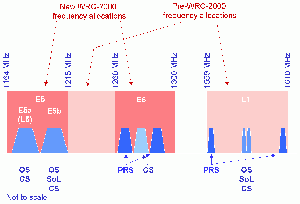If you wish to contribute or participate in the discussions about articles you are invited to contact the Editor
GALILEO Open Service: Difference between revisions
No edit summary |
|||
| Line 19: | Line 19: | ||
==Performance and features== | ==Performance and features== | ||
[[File:Galileo Frequencies.gif|Galileo Signal Frequencies|left|thumb]] | |||
The Open Service is realized by using the signals at L1, E5a and E5b, whether data or pilot. Several combinations are also possible, such as a dual frequency service based on using L1 and E5a (for best ionospheric error cancellation) or single frequency services (at L1, E5a, E5b or E5a and E5b together) in which case the ionospheric error is removed using a model, and even triple frequency services using all the signal together (L1, E5a and E5b), which can be exploited for very precise, centimetric applications.<ref name="ESA_GALILEO"/>.<ref>[http://ec.europa.eu/enterprise/policies/satnav/galileo/files/galileo-os-sis-icd-issue1-revision1_en.pdf Galileo OS SIS ICD Issue 1 Revision 1 September 2010e]</ref> | The Open Service is realized by using the signals at L1, E5a and E5b, whether data or pilot. Several combinations are also possible, such as a dual frequency service based on using L1 and E5a (for best ionospheric error cancellation) or single frequency services (at L1, E5a, E5b or E5a and E5b together) in which case the ionospheric error is removed using a model, and even triple frequency services using all the signal together (L1, E5a and E5b), which can be exploited for very precise, centimetric applications.<ref name="ESA_GALILEO"/>.<ref>[http://ec.europa.eu/enterprise/policies/satnav/galileo/files/galileo-os-sis-icd-issue1-revision1_en.pdf Galileo OS SIS ICD Issue 1 Revision 1 September 2010e]</ref> | ||
--------------------------- | --------------------------- | ||
Revision as of 07:38, 12 April 2011
| GALILEO | |
|---|---|
| Title | GALILEO Open Service |
| Author(s) | GMV |
| Level | Basic |
| Year of Publication | 2011 |
The GALILEO System will be an independent, global, European-controlled, satellite-based navigation system and will provide a number of guaranteed services to users equipped with Galileo-compatible receivers. The GALILEO Open Service results from a combination of open signals, free of user charge, and provides position and timing performance competitive with other GNSS systems.
Purpose
The Galileo Open Service (OS) provides positioning, velocity and timing information that can be accessed free of direct user charge. This service is suitable for mass-market applications, such as in-car navigation and hybridisation with mobile telephones. The Open Service is accessible to any user equipped with a receiver, with no authorisation required. While up to three separate signal frequencies are offered within the Open Service, cheap single-frequency receivers will be used for applications requiring only reduced accuracy. In general, Open Service applications will use a combination of Galileo and GPS signals, which will improve performance in severe environments such as urban areas. The timing service is synchronised with UTC when used with receivers in fixed locations. This timing service can be used for applications such as network synchronisation or scientific applications.[1]
The Open Service does not offer integrity information, and the determination of the quality of the signals will be left entirely to the users. There will be no service guarantee or liability from the Galileo Operating Company on the Open Service.[2]
Performance and features
The Open Service is realized by using the signals at L1, E5a and E5b, whether data or pilot. Several combinations are also possible, such as a dual frequency service based on using L1 and E5a (for best ionospheric error cancellation) or single frequency services (at L1, E5a, E5b or E5a and E5b together) in which case the ionospheric error is removed using a model, and even triple frequency services using all the signal together (L1, E5a and E5b), which can be exploited for very precise, centimetric applications.[2].[3]
During the Initial Operational Capability (IOC) phase, the GALILEO open service, the search and rescue service and the PRS will be provided. At this stage, however, accuracy and availability will not yet have reached their optimum levels.[4]
To know more information about Performances of each Galileo Service see the article Galileo Performances.


